Year-Round Yard Maintenance – All Seasons Yard Care
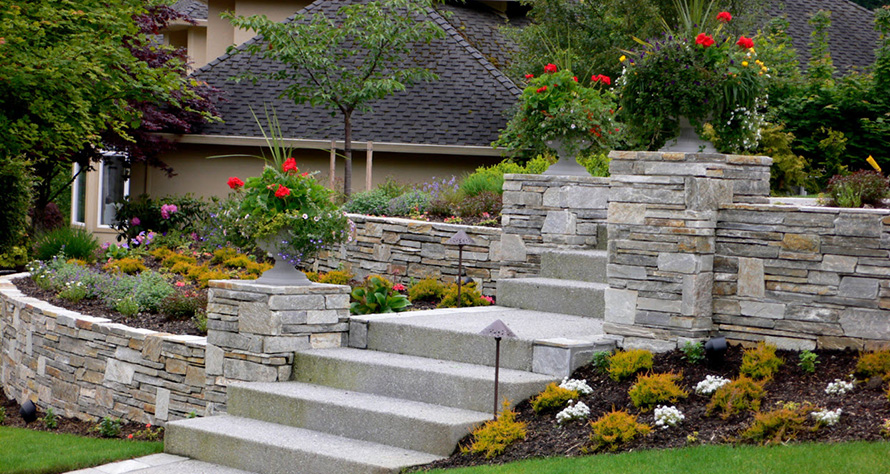
Ever walk through your neighborhood and notice how some yards look good no matter the season? Whatever the style, from finely manicured landscapes to less formal gardens, some yards always seem to be well-dressed – even in the dead of winter. Does a master gardener live in each of these homes? Probably not, but one thing they do all have in common: regular, year-round maintenance.
Whether you’re the DIY type or prefer to let someone else do the heavy lifting, following a seasonal schedule of care – and doing the right things at the right time – is the secret sauce to healthy lawns and thriving landscapes. So, here’s our seasonal guide to help you get through the year.
WINTER (January-Mid March)
Start planning! January is a great time to plan your yard, garden, and landscape projects for the year and decide what falls under DIY and what you want to hire out. You’ll want to schedule any landscape contractors or yard service early – before they get busy in the spring!
Test your soil before spring. You can buy a kit and do this yourself or have a pro come and test your soil for you. The advantage of hiring pros like the team at Landscape East & West – we can offer guidance as to what your lawn or garden is lacking and how to properly amend your soil before the growing season kicks in. A good rule of thumb for lawns: healthy lawns should be tested every three to four years, and problem spots annually.
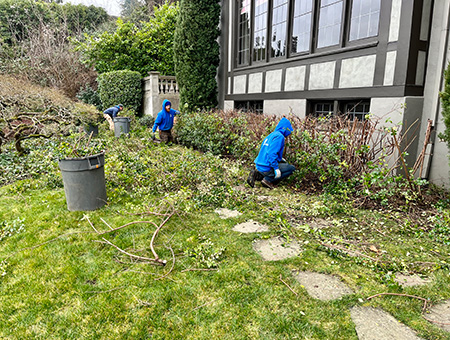 Prune trees and shrubs while they’re dormant. You can also prune established fruit trees and berries this time of year. Be sure to remove any diseased or damaged branches. If you’re not sure of how to prune, consult with a professional first, or simply hire this out. There’s nothing worse than a bad haircut and this is true for trees and shrubs too – they take even longer to grow out!
Prune trees and shrubs while they’re dormant. You can also prune established fruit trees and berries this time of year. Be sure to remove any diseased or damaged branches. If you’re not sure of how to prune, consult with a professional first, or simply hire this out. There’s nothing worse than a bad haircut and this is true for trees and shrubs too – they take even longer to grow out!
Remove leaves and yard debris from your lawn and around your plants and shrubs. Leaf debris will keep your lawn from growing and can stain your concrete surfaces. Consider setting aside an area of your yard to put a compost bin to turn those fall leaves into compost that you can use around your plants.
Prevent weeds before they sprout. Late winter is a great time to get a jump on any sprouting weeds before they can get a foothold in your yard. We recommend spreading 2 inches of organic mulch to keep weeds from germinating.
Treat your lawn for moss. Moss thrives in cool, wet weather, but this is also when it is the easiest to get rid of. An application of iron is a great option for removing moss and greening up your grass.
Cut back ornamental grasses to just a few inches above the ground in January to tidy up your winter landscape and make way for new spring growth. This will set up your ornamental grass care in spring and fall for mowing and pest care.
Take care of any hardscape repairs. If the seasons have taken their toll, don’t wait to make repairs. Mend fences, broken trellises, or arbors now, and make note of any larger repairs that may be needed in stone or concrete walls, water features, patios, etc. You’ll want to schedule any work to be hired out before the busy spring and summer seasons. Hardscapes are one of our specialties and we are always happy to help with your repairs or new ideas.
SPRING (March-May)
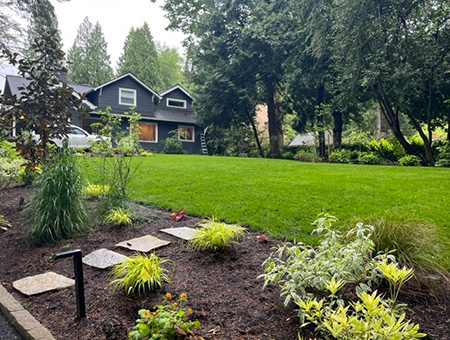 Firm up your big projects now. Confirm your contractors and get on their schedules early – especially if you want to enjoy your new landscape, deck, or patio by summer.
Firm up your big projects now. Confirm your contractors and get on their schedules early – especially if you want to enjoy your new landscape, deck, or patio by summer.
Test your irrigation system and schedule any repairs that may be necessary. If you are planning on installing a new system, don’t wait! Early spring is a great time to do this, while the ground is still soft.
Make note of any overly soggy sections of your lawn. Poor drainage is a common reason why lawns begin to look bad, but there is a multitude of options for improving drainage and reviving your lawn to its rightful lush state. This is a service we have been providing Portland-area homeowners for decades, so if you are not sure what to do, give us a call.
Plant trees and shrubs in spring while the weather is still cool and wet. The ground will be softer, and your new plantings will have time to get better established before the hot and drier days of summer. New plantings need more water than established plants.
Start mowing your lawn at the first signs of growth. If you have a regular maintenance service, make sure you are on the schedule to get this started up again and if you have been mowing your own lawn, maybe this is the year to consider hiring out. There are lots of additional services your landscape maintenance crew can provide to keep your lawn and yard healthy and looking its best year-round.
Fertilize your lawn and apply pre-emergent herbicides to prevent unwanted grasses and weeds before they can germinate. Spring is also a great time to overseed and repair brown or bare spots. For tips on how to fertilize a new lawn in the spring, start by fertilizing it 4 or 5 times during the season. Additional tips can be found on our blog.
Prune deciduous trees and shrubs if you haven’t already and, once the danger of frost has passed, prune any roses. To keep your landscaping looking fresh, thin out spring-blooming shrubs after the blossoms fade.
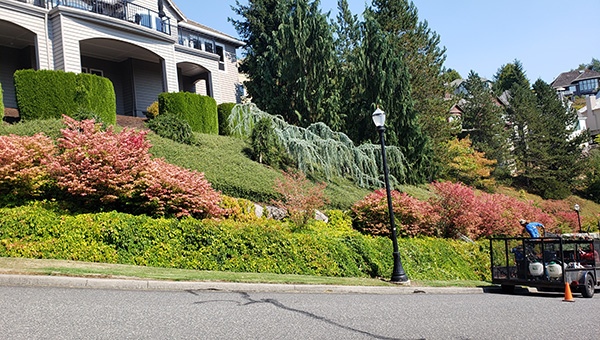 Fertilize your rhododendrons and azaleas with an acid-based fertilizer if needed. For a natural way to fertilize rhodies that is becoming popular in the Northwest, use coffee grounds. Fertilizing rhododendrons with coffee grounds in early spring, and again at the beginning of fall, will provide them with all the vital nutrients (in smaller quantities than commercial fertilizers) while making the soil slightly more acidic as well. You can also use a plant fertilizer with a nitrogen content between 10% and 14%.
Fertilize your rhododendrons and azaleas with an acid-based fertilizer if needed. For a natural way to fertilize rhodies that is becoming popular in the Northwest, use coffee grounds. Fertilizing rhododendrons with coffee grounds in early spring, and again at the beginning of fall, will provide them with all the vital nutrients (in smaller quantities than commercial fertilizers) while making the soil slightly more acidic as well. You can also use a plant fertilizer with a nitrogen content between 10% and 14%.
Apply a layer of mulch around plants once the soil is warm to discourage weeds and help retain moisture when drier weather returns. Add new mulch on top of your existing mulch but try not get more than 3” of mulch and keep the mulch away from the crown of the root ball.
Prune vines that are growing over arbors and trellises in the spring. This is something that tends to get overlooked and before you know it, your overgrown vines are taking down what was once a beautiful feature in your yard.
Schedule a complete yard clean-up! If the spring checklist is a bit too much for your busy schedule, hire a crew to come out and give your yard and landscape a spring tune-up. We recommend spring and fall clean-ups to keep your yard fresh and looking its best through the seasons.
Maintain your hardscapes. Clean wooden decks and re-seal or stain as needed; repair cracks in paved areas, lubricate or replace rusty latches and hinges, refresh gravel pathways, and repair any broken outdoor lighting fixtures. Do it now and you will be able to simply enjoy your outdoor spaces when the warm weather of summer returns.
SUMMER (June-August)
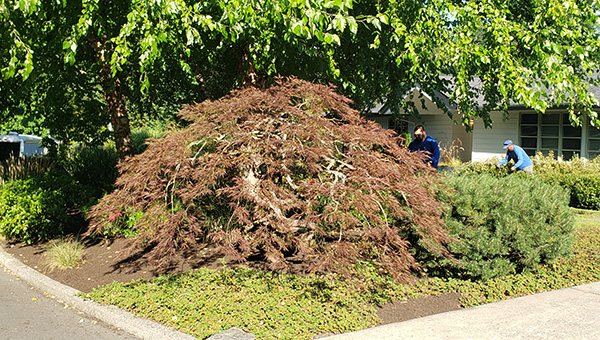 Plan your fall projects now. It’s not too late to think about adding special features or new plantings, or even giving your landscape a complete makeover. If you’ve been dreaming about a re-do, then contact your landscape designer and get on their fall schedule now.
Plan your fall projects now. It’s not too late to think about adding special features or new plantings, or even giving your landscape a complete makeover. If you’ve been dreaming about a re-do, then contact your landscape designer and get on their fall schedule now.
Keep your lawn hydrated, but not too much. Make sure your lawn is getting an inch of water a week – including rainfall. The tendency is to overwater, which can lead to all sorts of problems. Make sure when you water to do so in the early mornings. This will minimize evaporation and keep your lawn healthy and thriving.
Keep an eye on any new plantings from spring. These may be more susceptible to heat and drought and may need more water until they are established.
Trim hedges after the first wave of new growth and prune spring-blooming shrubs after the flowers fade. Conifer hedge trimming tips: The easiest way to trim an established conifer hedge is by using a powered hedge trimmer which will give clean edges. To make sure your hedges are level, use tall bamboo canes and a tape measure to mark the top edge along one side of the hedge. Sound like too much work? We offer a hedge-trimming service!
Treat your lawn for destructive turf pests like grubs that feed on grassroots. A sign of lawn pests is the mounds of dirt you may see in your yard, especially in the summer. These mounds can be caused by gophers, moles, and even insects like ants and termites. Other invaders that don’t make mounds can include crabgrass and other foreign grass species. For tips on how to get rid of crabgrass and other pests, call the professionals! Our lawn care services can help protect against these invaders before they get out of control.
Aerate compacted soil and dethatch your lawn as summer winds down or in the early weeks of fall. This will help with drainage and the overall health of your lawn through the rainy season. You can rent equipment, add this to your regularly scheduled yard maintenance, or hire a crew just for that job. We offer a full range of services like this for busy homeowners like you.
FALL (September – November)
Get started on those fall projects! You still have time to complete new hardscapes – patios, decks, retaining walls, walkways, before the rainy season sets in and the ground gets too muddy. Your contractor can help you schedule everything out, but best not to wait if you are wanting things completed by the end of the season.
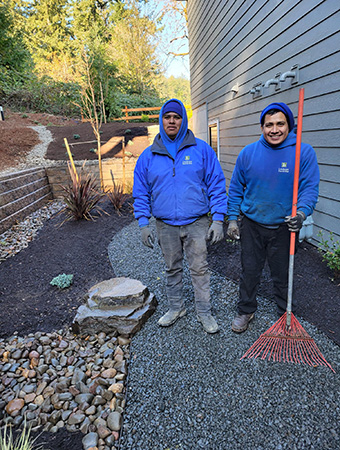 Complete your planting projects in early fall. This is a great time of year for new plantings or lawns as the cooler wetter weather provides the perfect growing climate and there is ample time for plants to get established for healthy root growth over the winter. If you are adding larger shrubs or trees, consider hiring a pro so that you can be sure your holes are big enough, heavy root balls are treated with care and your new plants are properly watered and fertilized to get them off to the best start.
Complete your planting projects in early fall. This is a great time of year for new plantings or lawns as the cooler wetter weather provides the perfect growing climate and there is ample time for plants to get established for healthy root growth over the winter. If you are adding larger shrubs or trees, consider hiring a pro so that you can be sure your holes are big enough, heavy root balls are treated with care and your new plants are properly watered and fertilized to get them off to the best start.
Feed your lawn in early fall for strong roots. We recommend using an organic or slow-release fertilizer that rain won’t wash away. You may also need to treat broadleaf weeds with spot treatments or weed and feed products that combine fertilizer and herbicide. Again, this is something that should be part of your regular yard service and is included in the services Landscape East & West provides.
Overseed new lawns or spots that need refreshing. Overseeding lawns in fall is a vital function of keeping your lawn healthy over the upcoming winter. Important note: We are frequently asked, “Can I mow after overseeding my lawn?” During the first two to four weeks post-aerating and overseeding, don’t mow. After you lay down your seedlings, they’ll need time and the right environmental protection to grow while acclimating and setting roots.
Keep mowing your lawn until the grass stops growing. In the Pacific Northwest, this is typically just before the first heavy frosts of the year in mid-November. The ideal grass height for winter is between 2 inches and 2.5 inches but depends on the type of grass in your yard. This length keeps the grass short enough to resist disease spread, but not so short that it becomes overly stressed by cold temperatures.
Plant spring bulbs now. For a bounty of spring blooms, and plant bulbs like daffodils, tulips, and crocuses now, add bulb fertilizer and keep watering until the rains return or the ground freezes. You should also dig up and store your non-hardy bulbs.
When is the best time to separate and replant perennials? Divide and replant overcrowded perennials in early fall so they have time to re-root over the winter and reward you with new growth in the spring. You can replant perennials every year as long as they were able to re-root in the winter.
Don’t let the leaves pile up! Rake fallen leaves and any other yard debris regularly! Unraked leaves can suffocate the grass and also provide a rich breeding ground for slugs and other pests. Of course, if you have a regular crew coming out from Landscape East & West, you won’t need to worry about this – we’ve got you covered!
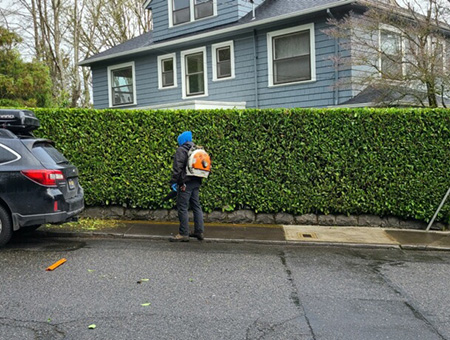 Schedule a fall clean-up. If you haven’t been having regular yard service, schedule a crew to give your yard and landscape one final clean-up for the season to remove old and dead plants, prune weak or diseased branches, and tidy up your landscape. Not only will your yard look fresher throughout the winter months, but you also minimize the risk of falling limbs during winter storms, and you will be one step ahead come next spring!
Schedule a fall clean-up. If you haven’t been having regular yard service, schedule a crew to give your yard and landscape one final clean-up for the season to remove old and dead plants, prune weak or diseased branches, and tidy up your landscape. Not only will your yard look fresher throughout the winter months, but you also minimize the risk of falling limbs during winter storms, and you will be one step ahead come next spring!
Drain irrigation systems and shut them down for the winter. If you have water features, you may want to drain these as well before freezing temperatures hit. Consult with your landscape professional if you’re not sure how to winterize your irrigation system or water features. We get questions like this all the time and are happy to consult.
Keep up with the maintenance. Whether you are total DIY, or you prefer to hire out yard work, plan on keeping up with your yard maintenance throughout the fall and the coming winter months. On-going maintenance will save you both time and money later, and as you can see by this list, a beautiful, thriving landscape needs year-round care.
Need Help with Your Landscape Maintenance?
We love making your design/build dreams a reality. From hardscaping to event location design to erosion prevention features, Landscape East & West is ready to help you create the outdoor living area you’ve always wanted. Call us at (503) 256-5302 and let’s get started on your project today!
